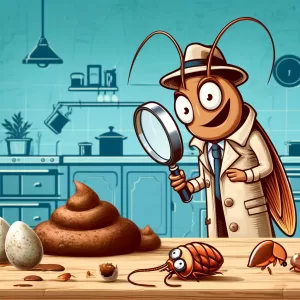Cockroach Eggs vs Poop: How to Tell the Difference
 When dealing with a cockroach infestation, it’s crucial to distinguish between cockroach eggs and poop to effectively manage and eliminate these pests. Understanding the differences can help you identify the extent of the infestation and take appropriate action. In this guide, we’ll explore the characteristics of cockroach eggs and poop, helping you to accurately identify them and implement effective pest control measures.
When dealing with a cockroach infestation, it’s crucial to distinguish between cockroach eggs and poop to effectively manage and eliminate these pests. Understanding the differences can help you identify the extent of the infestation and take appropriate action. In this guide, we’ll explore the characteristics of cockroach eggs and poop, helping you to accurately identify them and implement effective pest control measures.
Cockroach Eggs
Appearance and Characteristics
Cockroach eggs are encased in a protective shell called an ootheca. Each ootheca contains multiple eggs, depending on the species of cockroach. Here are some key features:
- Shape and Size: Cockroach eggs are oval-shaped and can vary in size. On average, they are about 5-9 mm long.
- Color: The ootheca is typically brown or dark brown, though the exact shade can vary slightly by species.
- Texture: The outer shell of the ootheca is smooth and hard, designed to protect the developing eggs inside.
Common Locations
Cockroaches tend to lay their eggs in hidden, undisturbed areas. Common places to find cockroach eggs include:
- Crevices and cracks: In walls, floors, and furniture.
- Kitchen appliances: Under and behind stoves, refrigerators, and dishwashers.
- Bathrooms: Around sinks, bathtubs, and behind toilets.
Cockroach Poop
Appearance and Characteristics
Cockroach poop varies in appearance depending on the size and species of the cockroach. Here are some general characteristics:
- Shape and Size: Cockroach droppings can range from small, coffee ground-like particles (for smaller species) to larger, cylindrical pellets (for larger species like the American cockroach).
- Color: Typically dark brown or black.
- Texture: The texture of cockroach poop can be granular or pellet-like, and it often has a distinct, musty odor.
Common Locations
Cockroach droppings can be found in areas where cockroaches are active. These include:
- Kitchens: Near food sources, in cupboards, and under sinks.
- Bathrooms: Around plumbing fixtures and in cabinets.
- Living areas: Along baseboards, in corners, and behind furniture.
How to Identify Cockroach Eggs vs Poop
Visual Inspection
- Eggs: Look for small, oval-shaped cases that are smooth and uniform in color.
- Poop: Look for irregularly shaped droppings that vary in size and have a granular or pellet-like appearance.
Location
- Eggs: Often found in hidden, undisturbed areas where cockroaches feel safe laying their eggs.
- Poop: Commonly found along cockroach pathways and near food and water sources.
Quantity
- Eggs: You may find a few oothecae in hidden spots.
- Poop: Usually more widespread, especially in areas where cockroaches are feeding and nesting.
Why It Matters
Identifying whether you are dealing with cockroach eggs or poop can help determine the severity of the infestation and the best course of action:
- Cockroach Eggs: Indicate potential for future infestations as each ootheca can hatch multiple nymphs.
- Cockroach Poop: Indicates active cockroach presence and the areas they frequent.
Control and Prevention
Sanitation
- Clean Regularly: Keep kitchens and bathrooms clean to reduce food and water sources.
- Seal Food: Store food in airtight containers and dispose of garbage regularly.
Eliminate Hiding Spots
- Seal Cracks and Crevices: Use caulk or other sealants to close off entry points and hiding spots.
- Reduce Clutter: Remove unnecessary items that can serve as hiding spots for cockroaches.
Use Baits and Insecticides
- Baits: Place cockroach baits in areas where you have identified cockroach activity.
- Insecticides: Use insecticides in targeted areas to reduce the cockroach population.
Professional Pest Control
For severe infestations, it may be necessary to consult professional pest control services. Professionals can provide comprehensive inspections and tailored treatment plans to effectively manage and eliminate cockroach infestations.
Understanding the differences between cockroach eggs and poop is essential for effective pest control. By accurately identifying these signs, you can take the necessary steps to control and prevent cockroach infestations, ensuring a clean and healthy living environment.
Stay vigilant and proactive in managing cockroach infestations. Regularly inspect your home, maintain cleanliness, and use appropriate pest control methods to keep your space cockroach-free. If the infestation is severe, don’t hesitate to seek professional help to ensure comprehensive treatment.
- The Life Span of a Cockroach
- Do Cockroaches Eat Clothes?
- Do Cockroaches Have Teeth?
- Shrimps and Cockroaches
- Will Sleeping with the Light On Keep Cockroaches Away?
- How to get roaches out of your car overnight
- Do Cockroaches Feel Pain?
- How Many Legs Do Cockroaches Have?
- Comparing Cockroach Eggs Size for Different Types of Cockroaches
- Identifying a Cockroach Bite on the Lips or Face
- Black Water Bug Identification and Control
- Why Do Water Bugs Come Out At Night?
- What Does Roach Rash Look Like?
- Can Cockroaches Bite Your Eyelid?
- Can Cockroaches Live in Your Balls?
- How did cockroaches get their name?
- Why Do Cockroaches Shed Their Skin?
- What Smell do Palmetto Bugs Hate?
- Baby Palmetto Bug: Identification and Control
- Cockroach Eggs vs Poop: How to Tell the Difference
- How to Get Rid of Water Bugs
- How Long Can a Cockroach Live Without Air?
- The Lifecycle of the German Cockroach: From Egg to Adult
- Do Mice Eat Roaches
- Wood Roach vs. Cockroach

